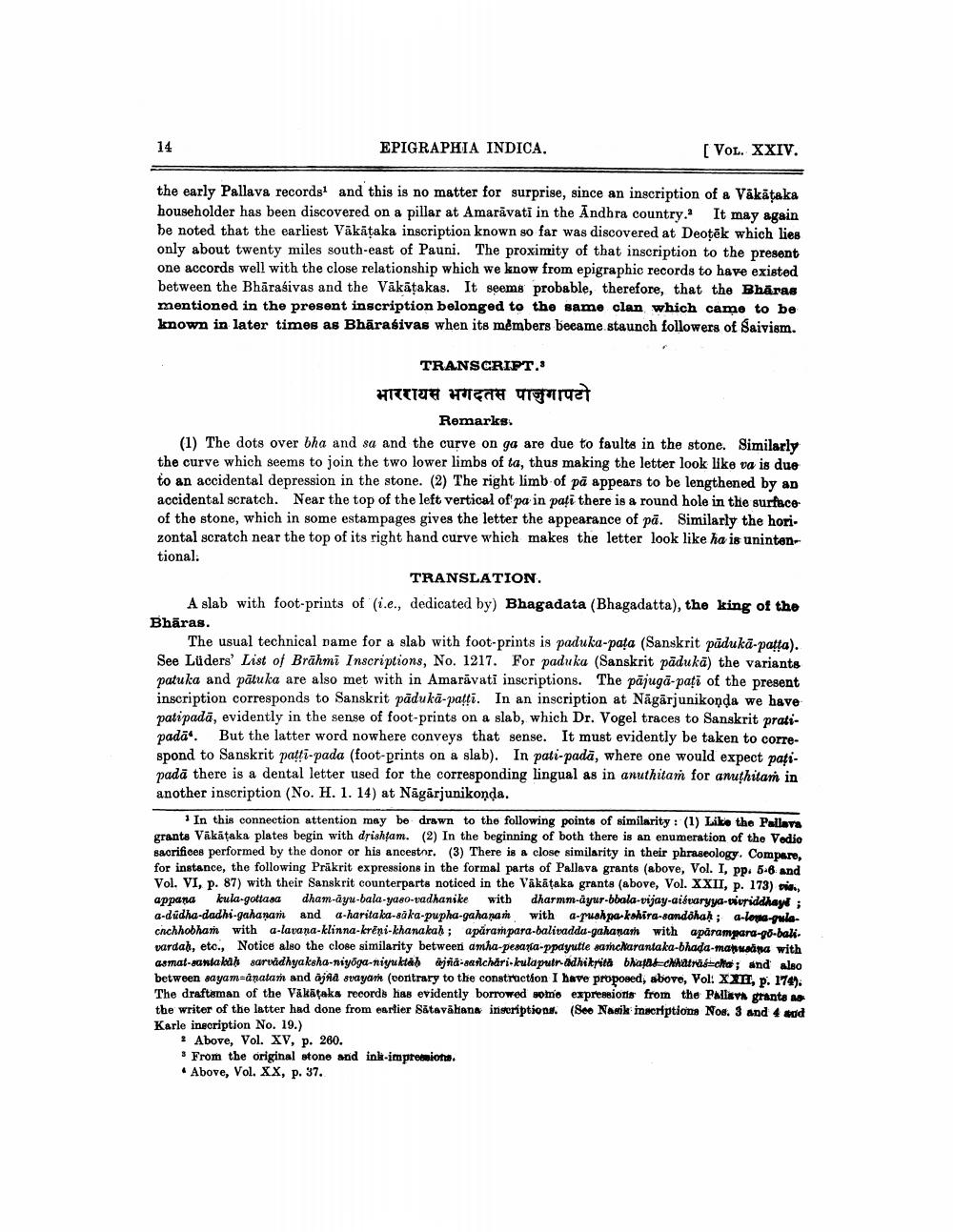________________
14
EPIGRAPHIA INDICA.
the early Pallava records1 and this is no matter for surprise, since an inscription of a Vakaṭaka householder has been discovered on a pillar at Amaravati in the Andhra country. It may again be noted that the earliest Väkäṭaka inscription known so far was discovered at Deotek which lies only about twenty miles south-east of Pauni. The proximity of that inscription to the present one accords well with the close relationship which we know from epigraphic records to have existed between the Bhārasivas and the Vākāṭakas. It seems probable, therefore, that the Bhāras mentioned in the present inscription belonged to the same clan which came to be known in later times as Bhārasivas when its members became staunch followers of Saivism.
TRANSCRIPT.
भाररायस भगदतस पालुगापटो
Remarks.
[VOL. XXIV.
(1) The dots over bha and sa and the curve on ga are due to faults in the stone. Similarly the curve which seems to join the two lower limbs of ta, thus making the letter look like va is due to an accidental depression in the stone. (2) The right limb of pa appears to be lengthened by an accidental scratch. Near the top of the left vertical of pa in pați there is a round hole in the surface of the stone, which in some estampages gives the letter the appearance of pa. Similarly the hori. zontal scratch near the top of its right hand curve which makes the letter look like ha is unintentional.
TRANSLATION.
A slab with foot-prints of (i.e., dedicated by) Bhagadata (Bhagadatta), the king of the Bhāras.
The usual technical name for a slab with foot-prints is paduka-pata (Sanskrit padukā-paṭṭa). See Lüders' List of Brahmi Inscriptions, No. 1217. For paduka (Sanskrit paduka) the variants patuka and patuka are also met with in Amaravati inscriptions. The pajuga-pați of the present inscription corresponds to Sanskrit paduka-patți. In an inscription at Nagarjunikonda we have patipada, evidently in the sense of foot-prints on a slab, which Dr. Vogel traces to Sanskrit pratipada. But the latter word nowhere conveys that sense. It must evidently be taken to correspond to Sanskrit patti-pada (foot-prints on a slab). In pati-pada, where one would expect pațipada there is a dental letter used for the corresponding lingual as in anuthitam for anuthitam in another inscription (No. H. 1. 14) at Nagarjunikoṇḍa.
1 In this connection attention may be drawn to the following points of similarity: (1) Like the Pallava grants Vākāṭaka plates begin with drishtam. (2) In the beginning of both there is an enumeration of the Vedio sacrifices performed by the donor or his ancestor. (3) There is a close similarity in their phraseology. Compare, for instance, the following Präkrit expressions in the formal parts of Pallava grants (above, Vol. I, pp. 5-6 and Vol. VI, p. 87) with their Sanskrit counterparts noticed in the Vākāṭaka grants (above, Vol. XXII, p. 173) via., appana kula-gottasa dham-ayu-bala-yaso-vadhanike with dharmm-ayur-bbala-vijay-aibvaryya-vivriddhaye; a-dudha-dadhi-gahanam and a-harita ka-saka-pupha-gahanam with a-pushpa-kshira-sandohaḥ; a-loma-gulachchhobham with a-lavana-klinna-kreni-khanakah; aparampara-balivadda-gahanam with apărampara-go-balivardab, etc., Notice also the close similarity between amha-pesana-ppayutte samcharantaka-bhada-manusana with asmat-santakaḥ sarvädhyaksha-niyoga-niyuktaḥ äjä-sanchari-kulaputr-adhikrita bhatas-chhatras-cha; and also between sayam-anatam and ajna svayam (contrary to the construction I have proposed, above, Vol: XXII, p. 174). The draftsman of the Väkätaks records has evidently borrowed some expressions from the Pallava grants as the writer of the latter had done from earlier Satavahana inscriptions. (See Nasik inscriptions Nos. 3 and 4 and Karle inscription No. 19.)
Above, Vol. XV, p. 260.
From the original stone and ink-impressions. Above, Vol. XX, p. 37.




